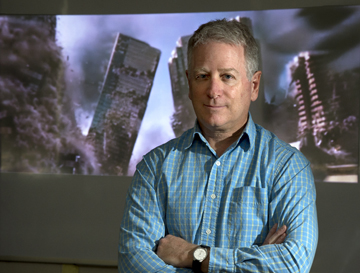Purdue Profiles: Andy Freed
November 4, 2013
 |
|
Andy Freed, professor of earth, atmospheric, and planetary sciences. (Purdue University photo/Mark Simons) |
A hiking trip to the Northern Cascade Mountains in Washington led then aeronautical engineer Andy Freed to discover a new challenge and career path: researching and teaching geophysics.
Freed is a professor of earth, atmospheric, and planetary sciences. As a researcher, he studies earthquakes and planetary surfaces, but as a professor he has fun teaching undergraduate non-majors about science through a class called Geosciences in the Cinema.
What did you do as a rocket designer and how that has helped you as a geophysicist?
I was an aerospace engineer for 10 years. I spent many years designing rockets and other space-bound objects. My job at the time was to develop numerical computer models for the space shuttle boosters, the space station, and satellites. Basically, you build these models to figure out whether they are going to work or fail. As you can imagine, any object you launch into space must go through some tough environments that are difficult to recreate here on the ground, so you use computer models to simulate what is likely to happen.
After I worked on the investigation and redesign of the space shuttle boosters following the Challenger accident, I was kind of burned out and looking for something else to do. The computational skills to do that kind work are applicable to many mechanical engineering problems, and the Earth is just another set of such problems. I needed a different setting and I like academics, so jumping into geophysics and studying plate tectonics seemed like a good path.
What research are you working on right now?
Earthquakes tend to come in bunches. Much of my research focuses on understanding how large earthquakes influence seismic hazards in the surrounding regions, determining whether nearby faults have been pushed closer to failure. For example, is Tokyo in more danger of a major earthquake following the 2011 M9 Tohoku earthquake? How about Port-au-Prince following the 2010 Haiti earthquake? The answer is probably yes in both cases.
I am also doing a lot planetary work. The same techniques I use to study earthquakes are also useful at understanding how planetary surfaces evolve. With many new spacecraft missions visiting places like Mercury and the moon, it's a very exciting time because we are receiving new images showing us details of these surfaces we have never seen before. There is much to learn about the other planets and what they tell us about the formation of our own planet, especially when their surfaces have not evolved much in several billion years.
How did you develop the class you teach, Geosciences in the Cinema?
When I first got here, I taught a class called Earthquakes and Volcanoes to non-majors. I found the material somewhat dry, and I think the students found the material somewhat dry, so occasionally I'd show some film clips of natural disaster movies to aid our discussions. I noticed in the student reviews of the class, especially in the questions about what can be done to improve the class, that I kept getting comments saying, "more film clips." One day I asked, "Would you be interested if I taught a whole class based on disaster movies where we'd actually watch movies and try and separate fact from fiction?" This received a resounding "Yes!" So I created Geosciences in the Cinema. It was a big hit from the beginning because everyone likes watching movies. And the students seem to really learn a lot about science during the process.
Each week, we watch a full-length feature covering a different aspect of natural hazards, like volcanoes, tsunamis, and global warming. They can watch it on their own, or we have a special screening of the movie each week. In addition, I probably show clips from another 10 movies in class. Some of the really cheesy movies are just humorous, but they still provide an opportunity to discuss, "Why are they humorous?" I try to mix a variety of good movies (for hurricanes we watch "The Perfect Storm"), and bad movies (for the Earth's internal structure we watch "The Core"), and I love showing clips of over-the-top terrible movies like "Sharknado." It enables me to engage with students who normally aren't interested in science. From the feedback I've received, I think they're enjoying it.
What are your future goals?
My future goals are to continue to enjoy teaching by continuing to reinvent my courses to keep them relevant to a changing world, not just for the students, but for myself as well. I also hope to continue international collaborations with the Japanese and the Haitians to help mitigate damage of future earthquakes through forecasting where and how big the next earthquakes are likely to be. More personally, my goal is to try to continue to strive for a balanced life between research, teaching and family.
Writer: Hannah Harper, harper4@purdue.edu
